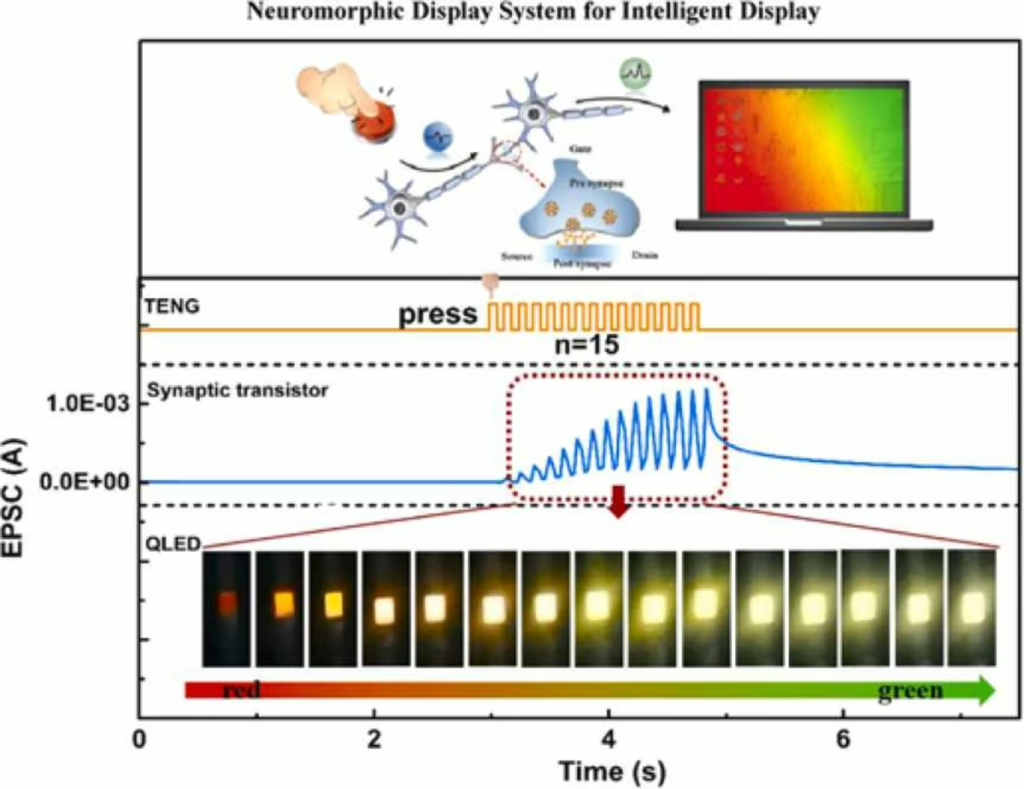Research out of Fuzhou University in China suggests an innovative development in display technology called the neuromorphic display, which merges display systems with artificial neural networks to create an intelligent, responsive interface.

Unlike traditional displays that rely on the Von Neumann architecture—where memory and processing are separate, leading to slower speeds and higher power consumption—this neuromorphic display integrates sensing, processing, and display functionalities within a single system. This design is inspired by the human brain’s ability to process information seamlessly, providing a more efficient and responsive interaction model.
The neuromorphic display achieves this functionality through a combination of several advanced components. Triboelectric nanogenerators (TENG) serve as both sensors and self-powered units, detecting physical stimuli such as touch and converting these into electrical signals. Electrolyte synaptic transistors, which function similarly to synapses in the brain, act as processors that efficiently transmit and process these signals with low power requirements. The information is then visually displayed by quantum-dot light-emitting diodes (QLEDs), which change color to represent the system’s response to environmental inputs.

Beyond basic functions of brightness and color adjustment, the neuromorphic display can autonomously “learn” and respond to stimuli, such as changing color based on the type of touch it detects, making it highly applicable in interactive and adaptive interfaces. To streamline this process, the researchers introduced a one-transistor one-synaptic transistor (1T1S) pixel circuit design, directly incorporating neuromorphic processing into each display pixel. This reduces the complexity found in conventional circuits that require multiple transistors and capacitors, enhancing both efficiency and functionality.
This neuromorphic display offers promising applications in various fields, including touch-responsive interfaces, intelligent wallpapers, robotics, and medical monitoring devices. The simplified pixel design further supports the potential for high-resolution, energy-efficient displays. In essence, this research signals a transformative shift toward more intelligent, dynamic, and energy-saving display technologies that interact with users in ways previously limited to science fiction.
The concept of neuromorphic displays is not a discovery in itself. Researchers have developed neuromorphic display platforms that adapt to ambient light conditions. By integrating artificial synapses with light-emitting units, these displays can adjust their brightness and contrast in real-time, enhancing visual comfort and energy efficiency.
Advancements in neuromorphic vision sensors have led to the development of displays capable of near-sensor and in-sensor computing. These sensors process visual information efficiently, reducing latency and power consumption, which is beneficial for applications requiring real-time image processing.
The nature of man-machine interfaces is likely to change with greater integration of AI systems and interfaces. The display is at the core of the connection between man and machine. Technologies like neuromorphic displays hold promise for better, more interactive, more efficient, displays.
References
- Chen, Q., Zhang, X., Liu, Y., Yan, Y., Yu, R., Wang, X., Lin, Z., Zeng, H., Liu, L., Chen, H., & Guo, T. (2022). Neuromorphic display system for intelligent display. Nano Energy, 94, 106931. https://doi.org/10.1016/j.nanoen.2022.106931
- Liu, S., Zhang, X., Ren, Z., Cai, Y., Liu, D., Guo, T., & Chen, H. (2024). Neuromorphic Global Driving Strategy for Display. IEEE Electron Device Letters, 45(8), 1484–1487. IEEE Electron Device Letters. https://doi.org/10.1109/LED.2024.3410177
- Progress of Materials and Devices for Neuromorphic Vision Sensors | Nano-Micro Letters. (n.d.). Retrieved November 14, 2024, from https://link.springer.com/article/10.1007/s40820-022-00945-y
- Ren, Z., Zhang, X., Liu, S., Liu, D., Qin, N., Guo, T., & Chen, H. (2024). A Novel Neuromorphic Display Platform for Ambient Light Adaptive Display. IEEE Transactions on Electron Devices, 71(8), 5146–5149. IEEE Transactions on Electron Devices. https://doi.org/10.1109/TED.2024.3419765

